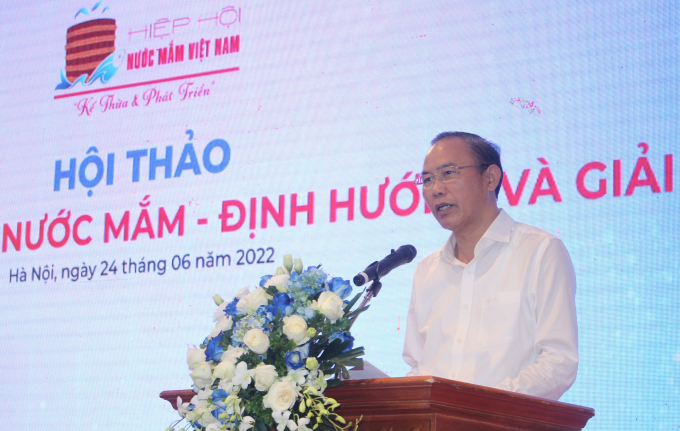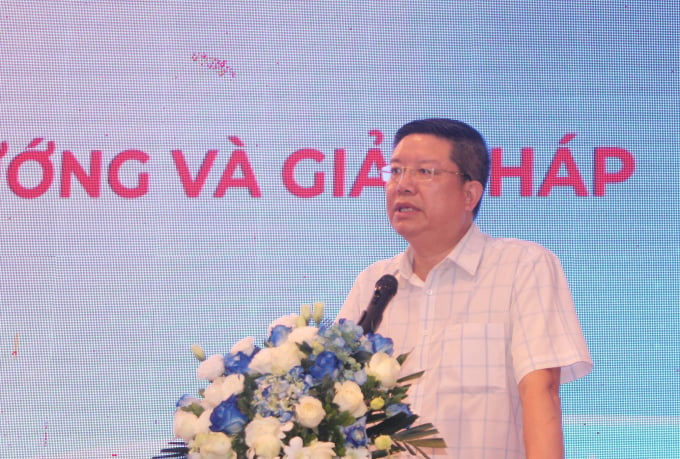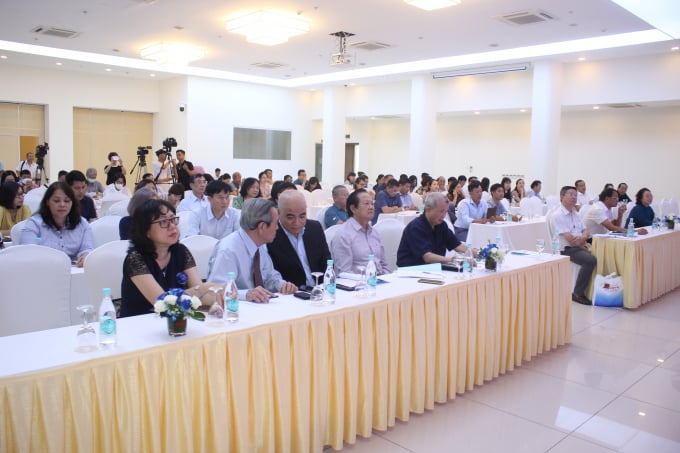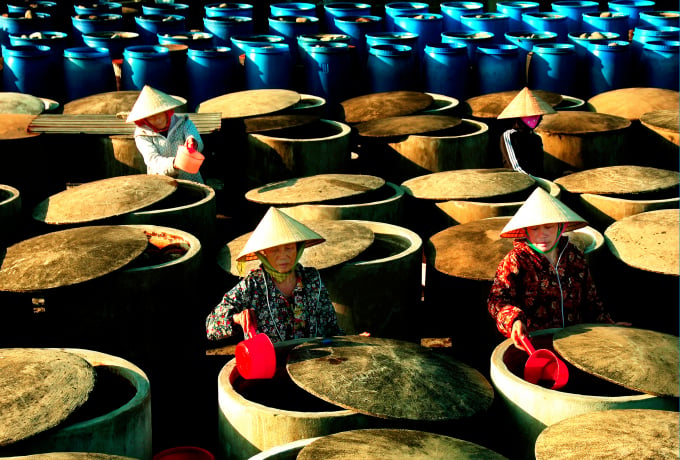May 31, 2025 | 09:33 GMT +7
May 31, 2025 | 09:33 GMT +7
Hotline: 0913.378.918
May 31, 2025 | 09:33 GMT +7
Hotline: 0913.378.918
The Vietnam Association of Fish Sauce, in collaboration with the Department of Processing and Market Development of Agricultural Products (MARD), and the Vietnam Association of Culinary Culture, has held a workshop on "Promoting the export of fish sauce - Orientation and solutions”.

According to Deputy Minister of Agriculture and Rural Development Phung Duc Tien, fish sauce products must ensure traceability and meet regulations on food safety. Photo: Trung Quan.
According to Mr. Tran Dang, Chairman of the Vietnam Association of Fish Sauce, Vietnamese fish sauce industry has applied science and technology in production, ensuring the standards of food hygiene and safety.
Fish sauce currently serves the needs of domestic consumers and it is exported to many countries around the world; promoting Vietnamese culture and cuisine to international partners, bringing profits to the nation as well as businesses.
However, Vietnamese fish sauce is facing fierce competition in the export market with a modest market share compared to its potential.
The Vietnam Association of Fish Sauce has actively supported its members to promote and protect the brand. It also aims to increase the competitiveness of Vietnamese fish sauce in the international market.
The Association has linked scientific research units and organizations to establish highly applicable programs and projects. These works can then help fish sauce producers increase efficiency, manufacture quality fish sauce products while meeting technical requirements following international standards.
Mr. Le Thanh Hoa, Deputy Director of the Department of Agricultural Products Processing and Market Development shared: There have been many Vietnamese fish sauce products successfully exported to foreign markets. This means that the technical barriers and strict requirements of the importing markets are not too difficult to overcome if we strictly follow a unified and methodical process.
However, fish sauce producers and traders need to improve the production process, actively apply scientific and technological advances to improve the quality of fish sauce as well as pay special attention to the histamine content in traditional fish sauce.
In addition, units also need to improve packaging and labels to increase the products' appeal and competitiveness, creating favorable conditions for the export of Vietnamese fish sauce products to foreign markets.

According to Mr. Le Thanh Hoa, technical barriers and strict requirements of the importing markets are not too difficult to overcome if production and business activities strictly follows a unified and methodical process. Photo: Trung Quan.
At the workshop, the participants discussed the restoration and development of fish sauce processing models and villages; the establishment of geographical indications and trademarks for regional specialty fish sauce and OCOP products; the necessity of developing research topics to assess the risks and dangers of histamine in fish sauce, create favorable conditions for export.
Deputy Minister of Agriculture and Rural Development Phung Duc Tien highly commended the efforts, activities and contributions by the Vietnam Association of Fish Sauce in gathering and uniting members to promote production as well as protect the Vietnamese fish sauce brand in the international market, contributing to the economic and social development of the country.
According to Deputy Minister Phung Duc Tien, Vietnam currently has over 4,200 establishments engaged in fish sauce production, with 1,000 pure fish sauce production facilities, 60 bottling facilities, and 3,100 households engaged in fish sauce production approximately.
According to data published by the General Statistics Office, Vietnam's average fish sauce output in 2020 reached nearly 380 million liters. On average, Vietnamese people consume nearly 3.9 liters of fish sauce per person annually.
There are over 9300 workers directly involved in the production and trading of fish sauce in the country. The profession of producing fish sauce has created jobs and livelihoods for nearly 10,000 workers as well as millions of fishermen exploiting, purchasing aquatic products and mining coastal salt.

At the workshop, the participants discussed the promotion of fish sauce exports in the immediate future. Photo: Trung Quan.
Regarding the export numbers, the national average fish sauce export turnover reached 12.6% of the total output; with main targets markets including: Asia (54%), Australia (18%), Europe (13%), America (13%). The total fish sauce export turnover in 2021 reached 28.53 million USD (an increase of 21.7% compared to 2020).
These are positive signals that the Vietnamse fish sauce industry has great potential for strong development in the near future.
“A country that aims towards industrialization and modernization must have a safe food production industry, because safe food will determine the health, intelligence and development of its people. The current production of fish sauce is the embodiment of advanced production activities imbued with national identity. These are solid fulcrums for this industry to gradually assert its position, and improve by leaps and bounds in the future", said Deputy Minister Phung Duc Tien.
The Deputy Minister noted that in order to sustainably develop the export of fish sauce, it is necessary to: Ensure the source of raw materials in terms of both quantity and quality; adjust the mindset that every fish that cannot be sold frozen or fresh will be made into fish sauce; organize fleets of fishing vessels that specialize in fish sauce production and salting right on the vessels to ensure the quality of input materials for fish sauce processing.
The fish sauce industry must also upgrade infrastructure, factories, containers in the process of fish sauce production and processing. Furthermore, it must apply quality management programs, pay special attention to packaging, product labels, ensure food safety and protect the environment.

The Vietnam Association of Fish Sauce has actively supported its members to promote and protect the national brand as well as increase the competitiveness of the Vietnamese fish sauce exports in the international market.
Stakeholders must strengthen inspection, monitor closely and issue strict sanctions against the abuse of chemicals and additives in processing, extracting, bottling fish sauce, using excessive amounts of additives for coloring, flavoring, and preservatives that are not permitted by the Ministry of Health.
Restore and promote models and craft villages of fish sauce processing with long-standing traditional values, establish geographical indications, regional specialty fish sauce brands, and OCOP products.
Research tastes, expand export markets with a variety of fish sauce types. Products on sale must ensure full traceability records as well as meet the regulations on food safety. Consequently, we can slowly build a national brand for Vietnamese fish sauce.
Translated by Nguyen Hai Long

(VAN) Seafood by-products are opening a new path, combining green growth and technological innovation to enhance the industry's value.

(VAN) Mr. Nguyen Thanh Cong, Vice Chairman of the Son La Provincial People's Committee, reflects on Son La’s journey from barren hills to fruitful orchards after a decade of hard work.

(VAN) FAO’s Director-General addresses the 5th Baghdad International Water Conference.
/2025/05/26/1716-4-nongnghiep-191706.jpg)
(VAN) Chain linkages, technological innovation, and raw material zoning are three strategic pillars for the coconut industry to strongly develop and elevate its position on the global agricultural map.
![Advanced mariculture – an inevitable trend: [4] Accompanied by scientists](https://t.ex-cdn.com/nongnghiepmoitruong.vn/608w/files/sohk/2025/05/13/1941-pgsts-vo-van-nha-140958_717.jpg)
(VAN) According to Assoc. Prof. Dr. Vo Van Nha, Director of the RIA III, the development of advanced offshore mariculture is no longer an option but an essential path for Vietnam’s fisheries sector.

(VAN) Vietnam is intensifying the development of mollusk farming areas that meet international standards, aiming for sustainable growth and enhancing its export position in the global seafood market.
![Advanced mariculture – an inevitable trend: [3] Policy-driven momentum](https://t.ex-cdn.com/nongnghiepmoitruong.vn/608w/files/doanhtq/2025/05/21/0104-0616-0348-nuoi-bien-170339_789.jpg)
(VAN) To ensure the success of offshore mariculture that uses advanced technologies, it is essential to establish supportive policies that inspire both individuals and enterprises to invest with confidence.